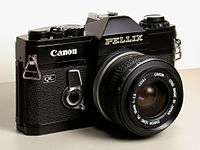Canon Pellix

The Canon Pellix is a manual focus camera released in 1965 that uses a semitransparent stationary reflex mirror behind which a metering cell is raised during the reading.[1]
The First Canon with TTL

Canon's sudden switch from professionally oriented SLR cameras to advanced amateur cameras happened in March 1964 when they left the Canon Canonflex range and launched the Canon FX with the FL lens mount. It has a built in CdS exposure meter with a circular window on the right-hand camera front. The Canon FP without exposure meter was added later the same year. The cameras were well built, but the metering technology was several years behind the Minolta SR-7 which pioneered that technology in 1962.[2] Then just half a year later, in the spring of 1965 Canon surprised the camera community with the remarkable Pellix. The new camera featured the much-expected TTL exposure metering facility, albeit employing the stop-down metering method.
However, what makes the Pellix special, is that the TTL metering is accomplished using a stationary semitransparent pellicle reflex mirror instead of the traditional moving SLR mirror and placing a CdS meter cell behind it for the TTL exposure measurement. The cell, attached to an arm is swung up in front of the film gate using the stop down lever on the right-hand camera front, reading the light projected from the camera lens after passing through the semitransparent mirror. Very few alternative locations inside the camera were available for picking up light rays from the camera lens. The Topcon RE Super has its meter cell placed directly behind the reflex mirror into which a pattern of slits are cut to let the light though, while the Asahi Pentax Spotmatic has a pair of cells located either side of the finder window reading light off the focusing screen.
The stop-down lever at the right-hand camera front also operates the self-timer. Pushing the lever towards the lens activates the stop down match-needle meter, while pulling in the opposite direction winds the timer. As with the Canon FX and FP, the camera back is opened turning a key at the base. The film speed is set lifting and turning the rim of the shutter speed dial. The camera is designed for the obsolete 1.35 volt mercury battery, which fortunately may be directly replaced by a similar 1.4 volt hearing aid battery, it is usable for about a year after activation whether used or not. The battery compartment is at the left-hand edge of the camera, next to the rewind knob. The Pellix was replaced by the improved Canon Pellix QL first marketed in March 1966. Improvements included the addition of a quick film loading mechanism and contacts in the base of the battery compartment for a separately available electronic booster for the internal exposure meter.[3]
The pellicle mirror

The semitransparent fixed mirror in the Pellix, for the first time successfully used in a 35mm SLR camera, lets about two-thirds (66%) of the light from the lens pass directly through to the film, while the rest is reflected to the viewfinder.[1]
The object of this arrangement - apart from accomplishing TTL metering, is for a simpler construction, a less noisy operation, and to get rid of the finder blackout during exposure. That is a favourable proposition, but the design has its flaws; the obvious one being loss of light, about one half stop (- 0.5 EV) in the exposure through the semitransparent mirror, and about one and three-fourth stop (- 1.7 EV) dimmer finder compared to using a fully reflecting mirror. A more serious problem however, is that the image forming light rays has to pass through the stationary pellicle mirror - in itself an obstruction, but over time the mirror surfaces also become soiled; it scatters the light and therefore degrades the projected image that forms the image on the film. If this occurs, or the fragile mirror is damaged in any way it has to be replaced.
It is true the finder does not go black during exposure, but at small lens apertures, the eye has no time to adjust to the dark finder. The operating noise from the Pellix is surprisingly similar to that of the Canon FX using a moving reflex mirror. Canon made two fast lenses, the FL 50mm 1:1.4 and the FL 58mm 1:1.2, in order to compensate for the light loss, but fast lenses might increase the risk of the sun burning holes in the shutter curtain not being protected by a solid mirror; a fact anticipated and solved by providing the Pellix with a metal shutter curtain. Another obstacle is the risk of light finding its way into the camera by way of the finder window during exposure, since there is no mirror to block the path in its up-position. This was also anticipated, and a finder blind is provided which is operated by turning the ring under the rewind knob, especially useful when leaving the camera on a stand. The Meter circuit is susceptible to breakage due to the CdS meter arm being moved into position behind the pellicle mirror during exposure reading.[4] A special lens was made available for the Canon Pellix, the FLP 38mm 1:2.8, utilising the fact the camera has a stationary mirror that will not hit the lens' rear element. The FLP code indicates that this lens is exclusively to be used on Pellix camera.[3]
References
- 1 2 Rudolph Lea (1993). The Register of 35mm Single Lens Reflex Cameras Second Ed. Wittig Books Hückelhoven. ISBN 3-88984-130-9.
- ↑ Scheibel, Anni Rita; Scheibel, Josef (1999). 70 Jahre Minolta Kameratechnik - Von der Nifcalette [sic] bis zur Dynax 9 (in German) (3rd ed.). Stuttgart: Verlag der H. Lindemanns Buchhandlung. ISBN 3-89506-191-3. Retrieved 2012-10-16.
- 1 2 Peter Dechert (1992). Canon Single Lens Reflex Cameras 1959-1991. Historical Camera Publications, Washington. ISBN 1-879561-04-2.
- ↑ Ivor Matanle (1996). Collecting and using Classic SLRs. Thames & Hudson. ISBN 0-500-27901-2.
External links
| ||||||||||||||||||||||||||||||||||||||||||||||||||||